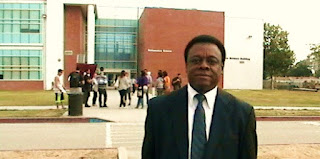The Manchester 4-Walls Project is a 3-year pilot program that prepares failing students for success in education and life. The 4-Walls Project partners include Beyond The Gap and Students of Color (SOC). St. Mary's Episcopal Church will also serve as an instruction site for the students. The partnership grew from the shared vision of providing services that will attack the achievement gap, reduce truancy and drop-out rates, and provide paths to gainful employment or post high school education for low-performing students who are really "on-the-bubble."
 |
| Norris McDonald, Sam Cephas, Rev. Josh Pawelek |
MC2 Technologies, Inc (MC2) provides training to young people through youth-at-risk programs. These programs include mentoring, tutoring, after school programs, scholarship assistance, life choices instruction and apprenticeship opportunities. Math and science are major emphases of MC2 programming. MC2's mission is to decrease truancy, reduce drop-out rates, raise student's GPA by one point, ensure success in core subjects, work primarily with low income students, provide scholarships to all program participants, promote retention for Connecticut colleges and universities, offer certifications and college credits, provide internship and co-op opportunities, teach financial literacy, build special curricula to overcome achievement gap, emphasize math and science and hands-on courses with field research.
The 4 Walls Project began in July 2012 and included discussions with local businessmen, town leaders, social service providers and surrounding colleges. The goal is to begin with 12-15 students during the first year.
 |
| Norris McDonald, Rev. Paul Briggs, pastor at St. Mary's Episcopal Church |
The first year of the program will introduce students to basic math, science and financial literacy principles and concepts, providing the student with the foundation that will enable them to participate in the second year program. Students will also be assigned to instruction teams during the first year that will provide individuals with professional knowledge and experience in the targeted field of study.
MC2 staff and volunteers work with students who are serious about making a difference in their own lives. Students are identified with the assistance of guidance counselors, teachers, parents and it is expected that a number of students will self-identify. Tutors work with these students to develop skills within the fields of mathematics, science, reading, writing, business -- utilizing desktop computers, interesting reading materials, and industry-related supplies and services, while also providing fun activities, such as games and field trips. Healthy food and beverages will also be available to ensure our young people remain mentally alert.
 |
| Sam Cephus, Norris McDonald, Dr. Duncan Harris |
In order to be accepted into the program, students are required to go through an application process, with the added requirement of a minimum 2.0 GPA. All students are required to attend seminars, programs or classes within the program three days a week. The students are required to fill out an application, provide a resume and letters of recommendation. Students are required to submit a writing sample; complete a pre-test that includes a math aptitude test; provide GPA and school attendance records, along with a letter from a current instructor and parental permission. The plan is that students accepted into MC are able to take their skills and leverage them into paid positions and acceptance into institutions of higher learning after high school.







